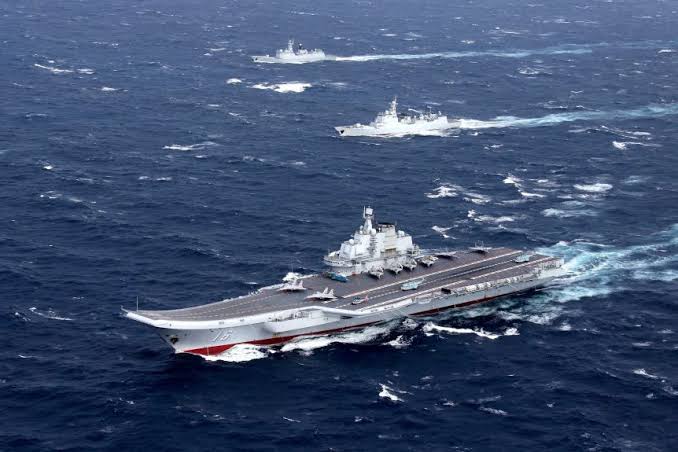South China Sea : Australia is worried about China’s activities — here’s why

By political reporter Jane Norman
China’s Liaoning aircraft carrier conducts a drill in an area of the South China Sea last year.
The South China Sea is more than 6,000 kilometres away from Canberra but Beijing’s activities in this contested body of water are causing deep anxiety within Australia’s defence and diplomatic circles.
At its heart, this is a dispute over competing territorial claims but the South China Sea has become a symbol of China’s inexorable rise and a shift in the global axis of power.
Here’s why Australia is concerned and how it’s responding to the issue.
Who’s involved in this dispute?
China is the main aggressor.
The country claims sovereignty over most of the South China Sea, including a bunch of small land formations, directly challenging the territorial claims of its neighbours — the Philippines, Vietnam, Taiwan and Malaysia.
These countries are all keen to exploit the vast fisheries and significant oil reserves that lie beneath.
So what’s the dispute about?
China’s motivations are both economic and strategic.
It claims “indisputable sovereignty” over an ambiguous Nine dash-line — basically a U-shaped area which takes in most of the South China Sea — and since 2012, it’s been using its considerable naval might to assert control over this area.
At the same time, China has seized small land formations and installed military bases on artificial islands it’s created by dredging 13 square kilometres of land from the ocean floor.
It means Beijing can now deploy combat aircraft and missile launchers to the islands at any time.
There is serious concern that China’s trying to assert control over the area, and project its power throughout the Indo-Pacific region, which is why the United States has got involved.
Why is Australia worried?
There are two reasons cited by the Government — “freedom of navigation” and “rules-based global order”.
The South China Sea is one of the world’s most important shipping lanes, between $3 trillion and $5 trillion worth of trade passes through the contested waters each year (estimates vary) — including more than half of Australia’s coal, iron ore and LNG exports.
So Australia has a big interest in keeping that trade route open.
The other concern is that China is threatening the “rules based global order,” which basically relies on all countries following international laws and resolving territorial disputes peacefully.
So, how has Australia responded?
Australia is in a tricky position — the United States is our strongest military ally, while China is our biggest trading partner. And both relationships are crucial.
Chinese and Australian Defence officials met in Canberra in November 2016.
While the risk of war between the US and China is considered to be low, it is the source of considerable tension.
Ultimately Australia does not want to see the South China Sea militarised and international trade routes compromised.
Publicly, Australia has taken a taken a relatively neutral position — refusing to take sides but calling for a “peaceful solution” to the disputes.
Australia has also been using diplomatic channels and forums to put pressure on China to end its military build-up.
On the defence front, RAAF planes regularly conduct surveillance flights and the Australian Navy sails through the contested waters all in the name of freedom of navigation.
But don’t get these confused with the more provocative Freedom of Navigation Operations (or “FONOPs”) the US has been carrying out.
What are the US and the Philippines doing?
Since 2015, the United States has conducted FONOPs to challenge China’s “excessive” claim.
The USS John S McCain conducts a patrol in the South China Sea while supporting security efforts in the region.
These operations, which infuriate China, involve US naval ships sailing within 12 nautical miles of China’s artificial islands — sending a message that the US does not recognise them as Chinese territory.
It’s not about “containing” China, according to the US, but maintaining this “rules based global order”.
But China does not see it that way. It has told the US to stay out of the dispute, and warned the FONOPs “severely harm China’s sovereignty and security”.
At the recent ASEAN forum, President Donald Trump took a typically unconventional approach, offering to “mediate” between China and the other parties. So far no-one’s taken him up on this offer.
The other big player was the Philippines, which up until recently was on the US side of the dispute.
The Philippines took China to the Permanent Court of Arbitration in The Hague which, in 2016, determined that Beijing had no historic rights over the South China Sea.
But China ignored this ruling, declaring it “neither accepts nor recognises it,” and the Philippines has since elected a new president who seems much less interested in pursuing this issue.
Rodrigo Duterte has only deepened his country’s ties with Chinese President Xi Jinping.
In fact, Rodrigo Duterte has only deepened his country’s ties with China, signing multi-billion dollar economic partnerships, and at the ASEAN summit all but confirmed his complete capitulation.
“The other hotheads would like us to confront China and the rest of the world for so many issues,” he said.
“The South China Sea is better left untouched. Nobody can afford to go to war.”
That is true, but also a sign that old alliances are shifting, further complicating this already complex situation.
For now at least, China’s slowed down its military build-up in the South China Sea but all eyes are on these contested waters, waiting for its next move.



